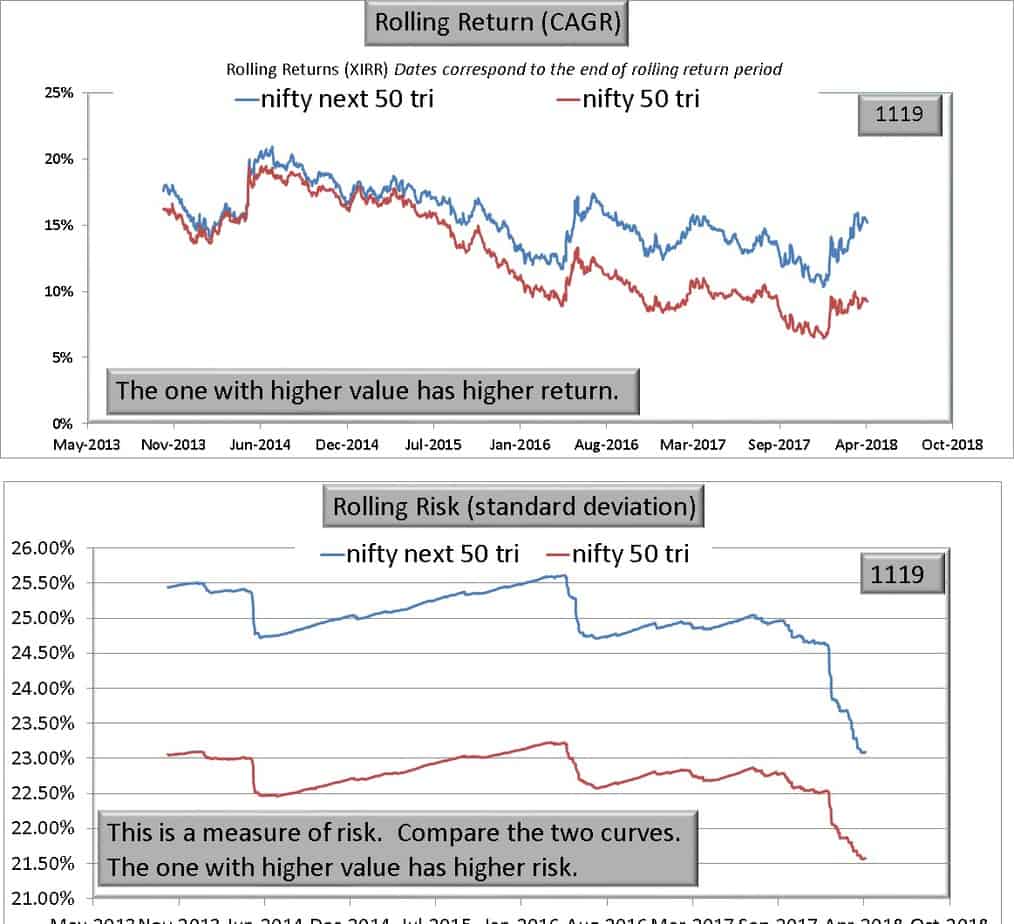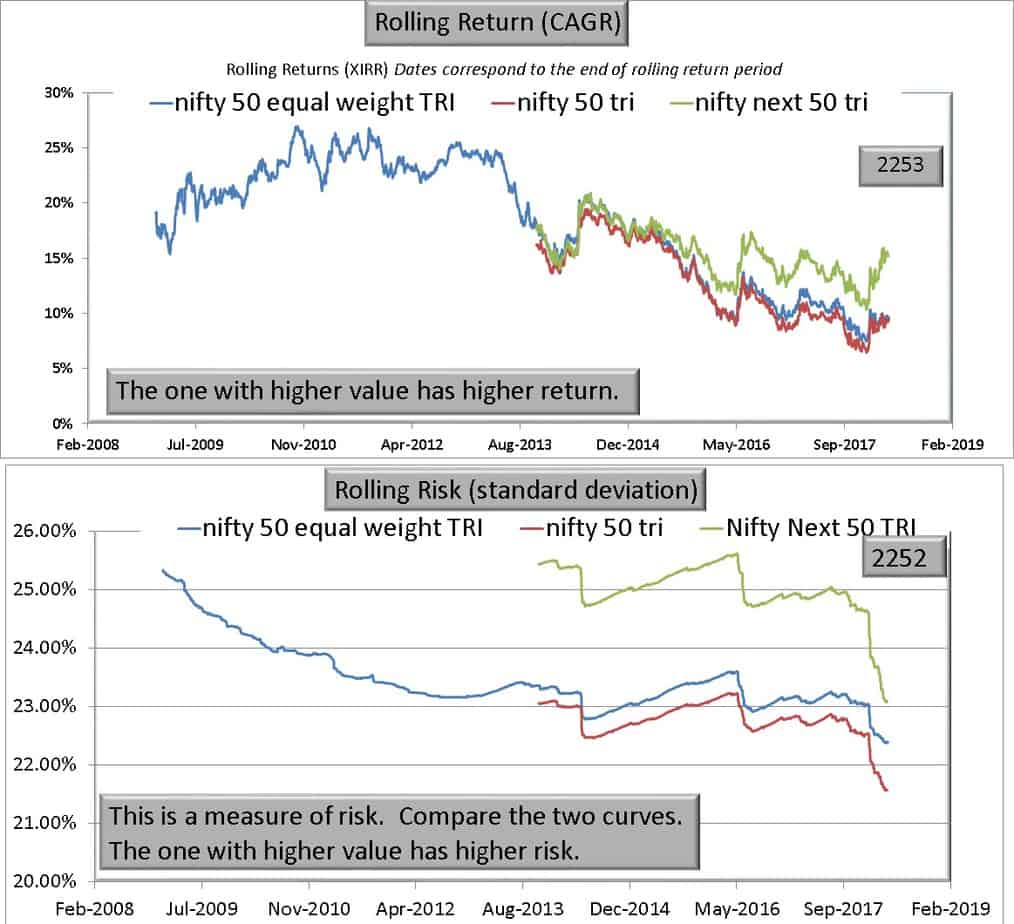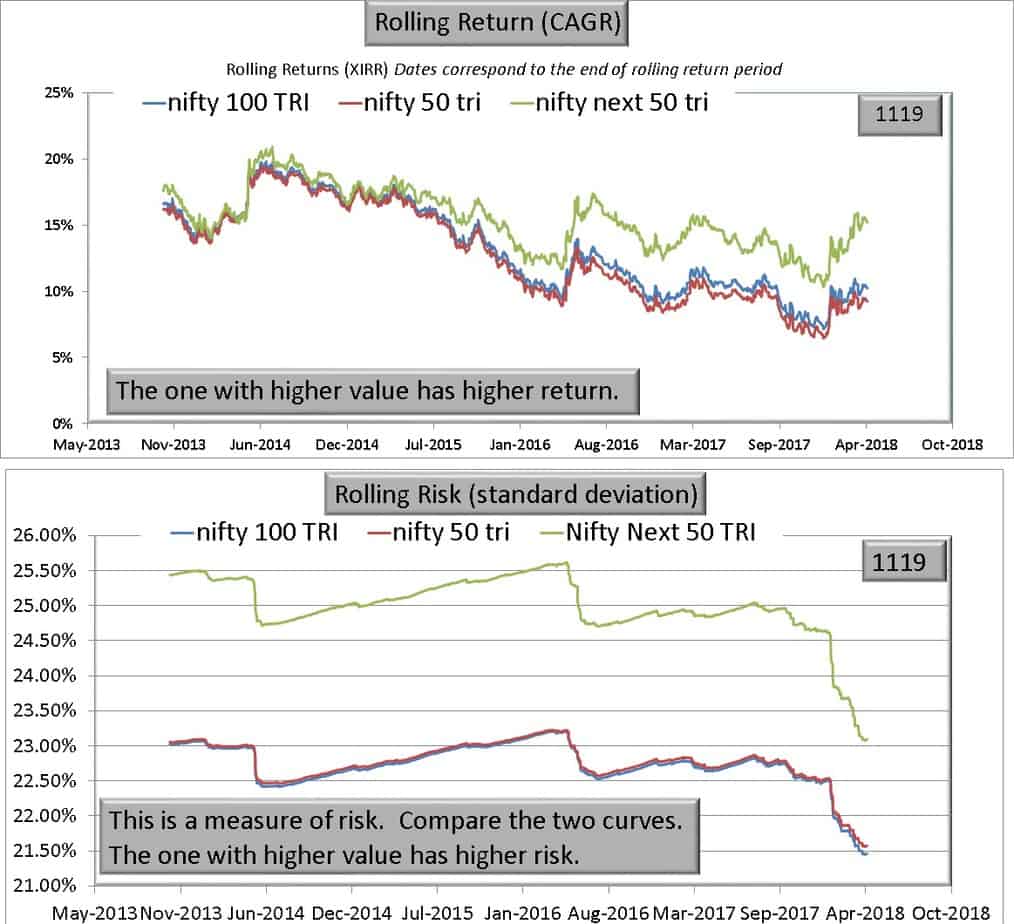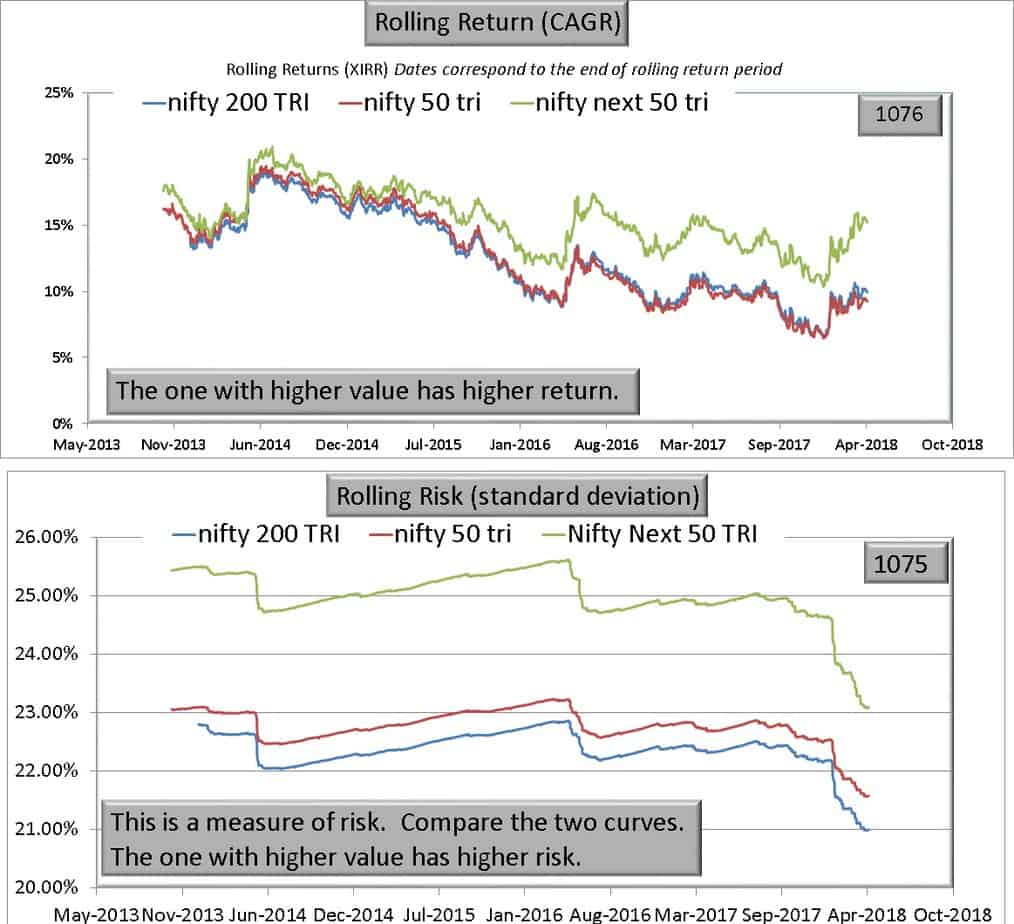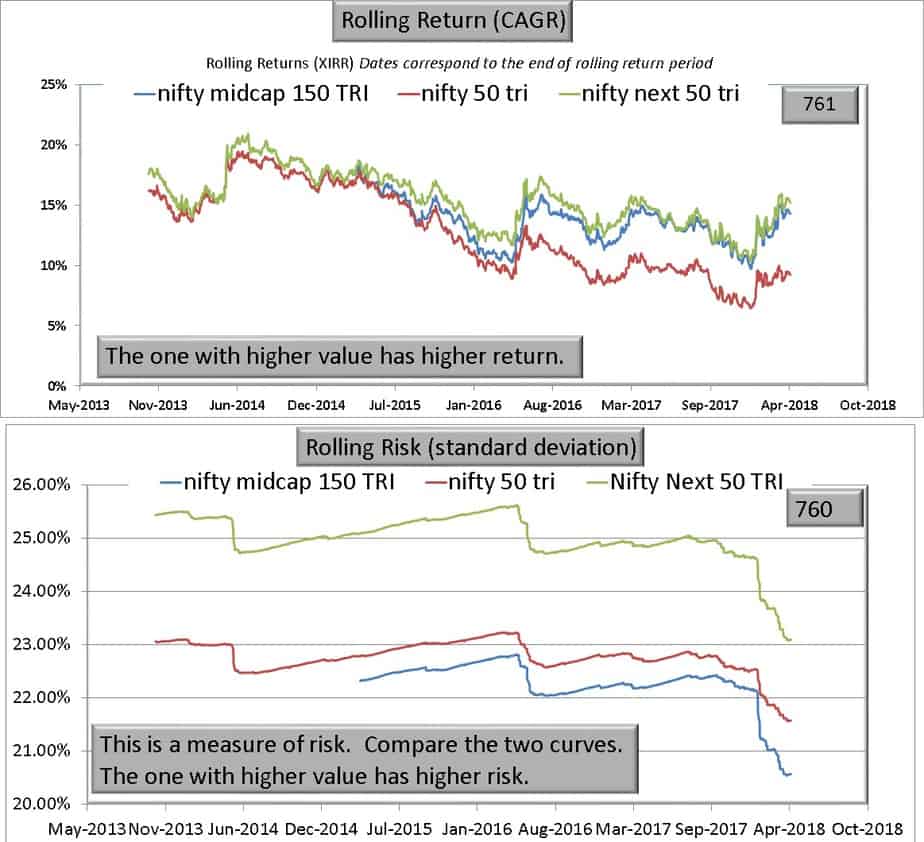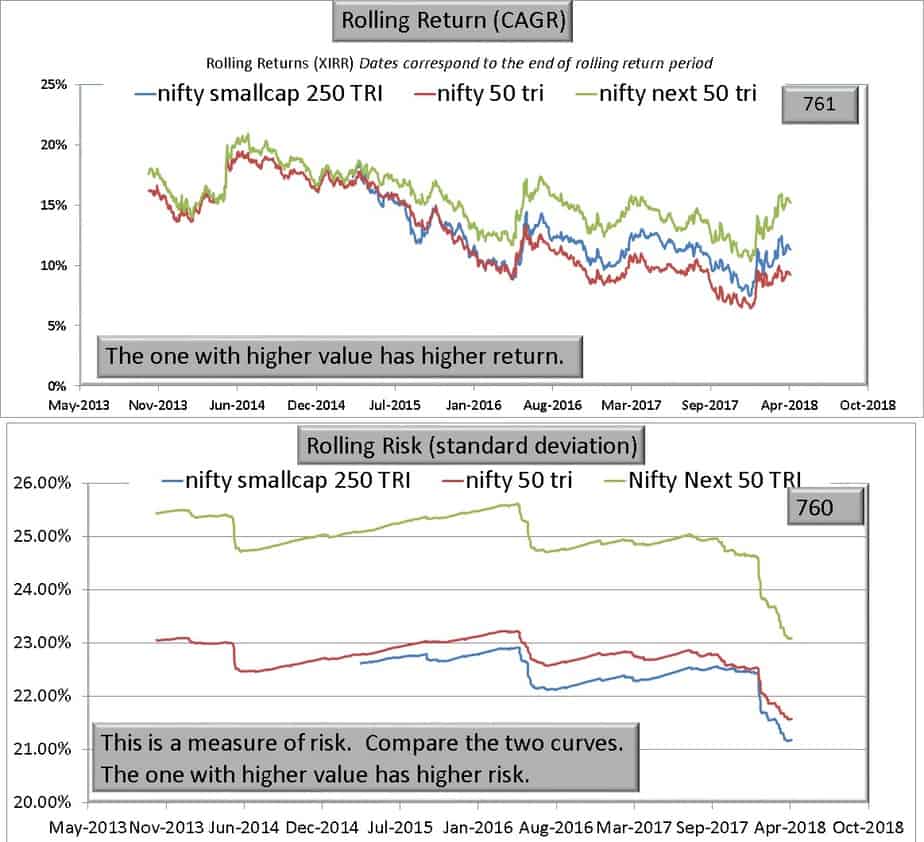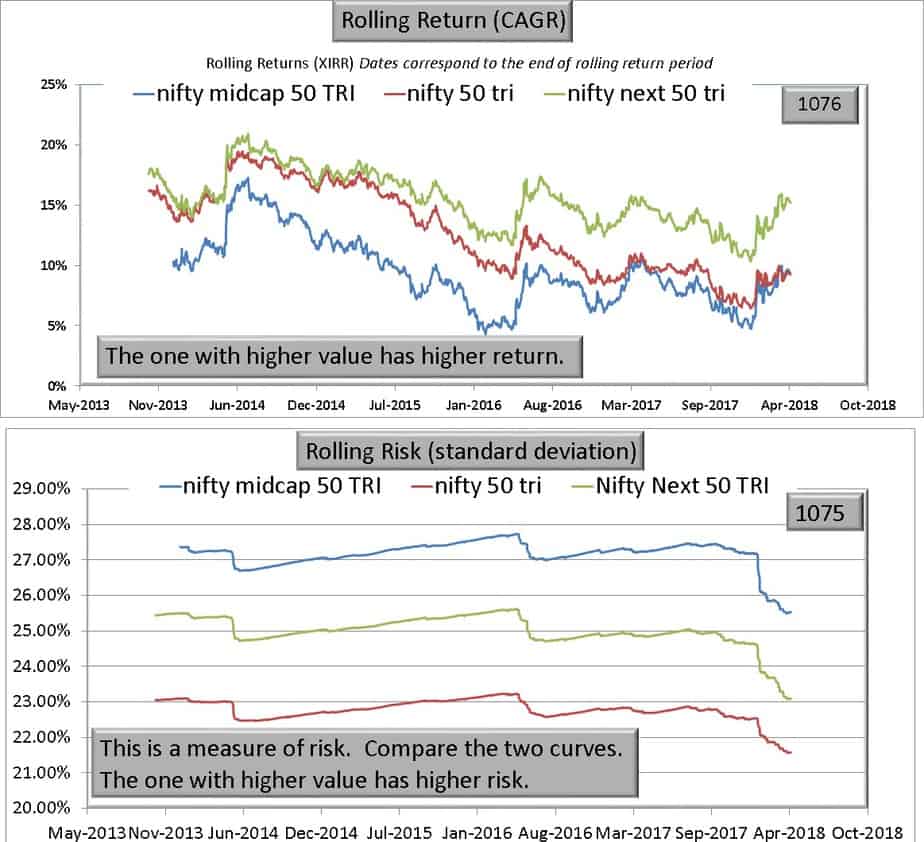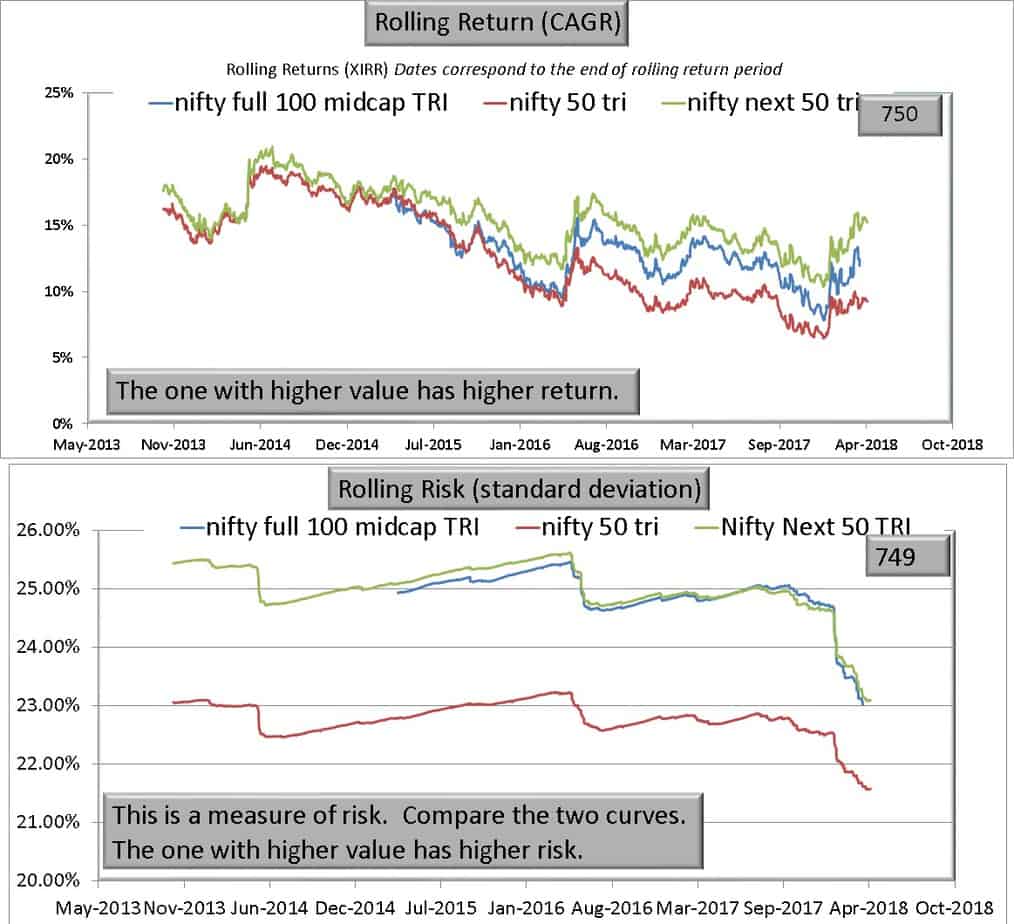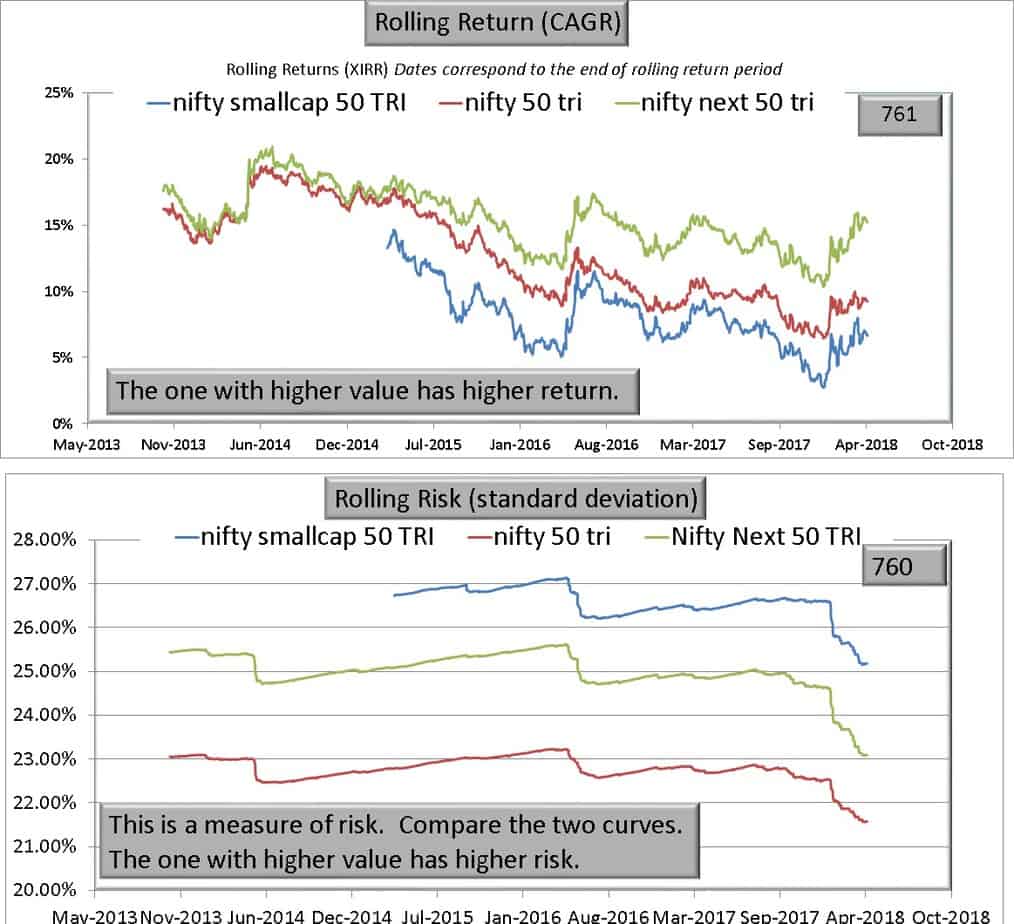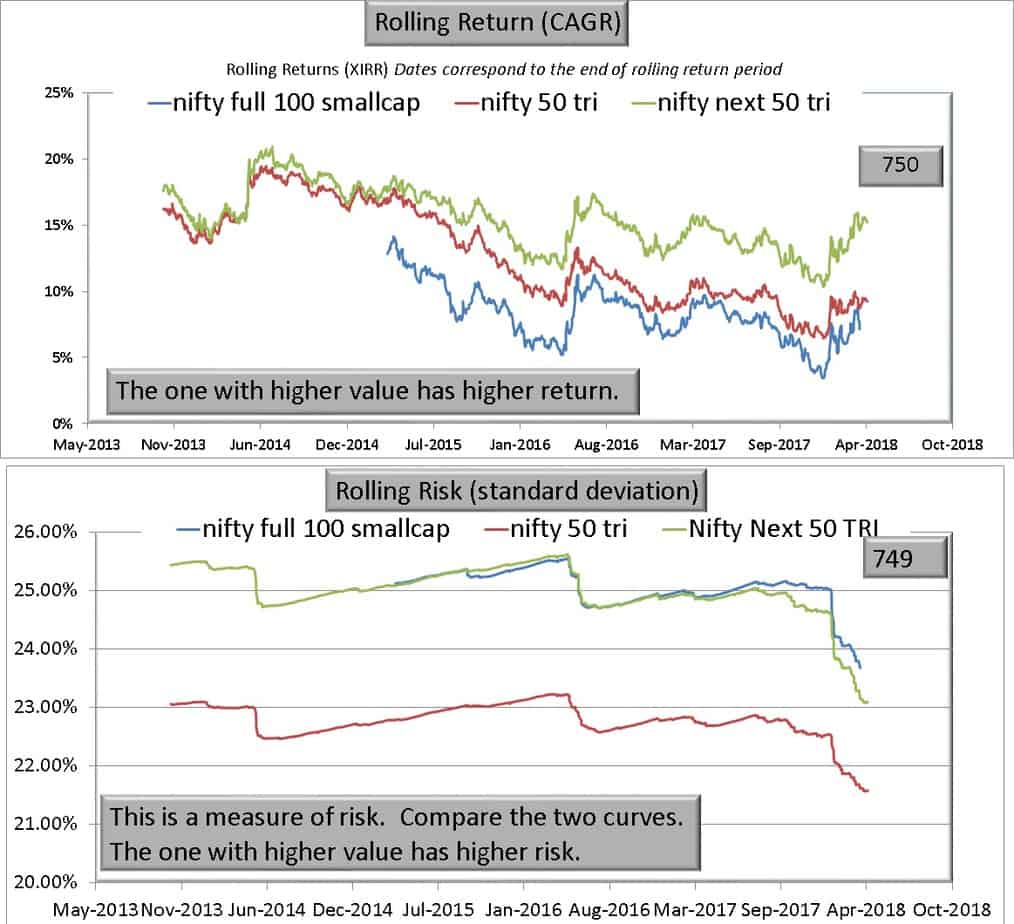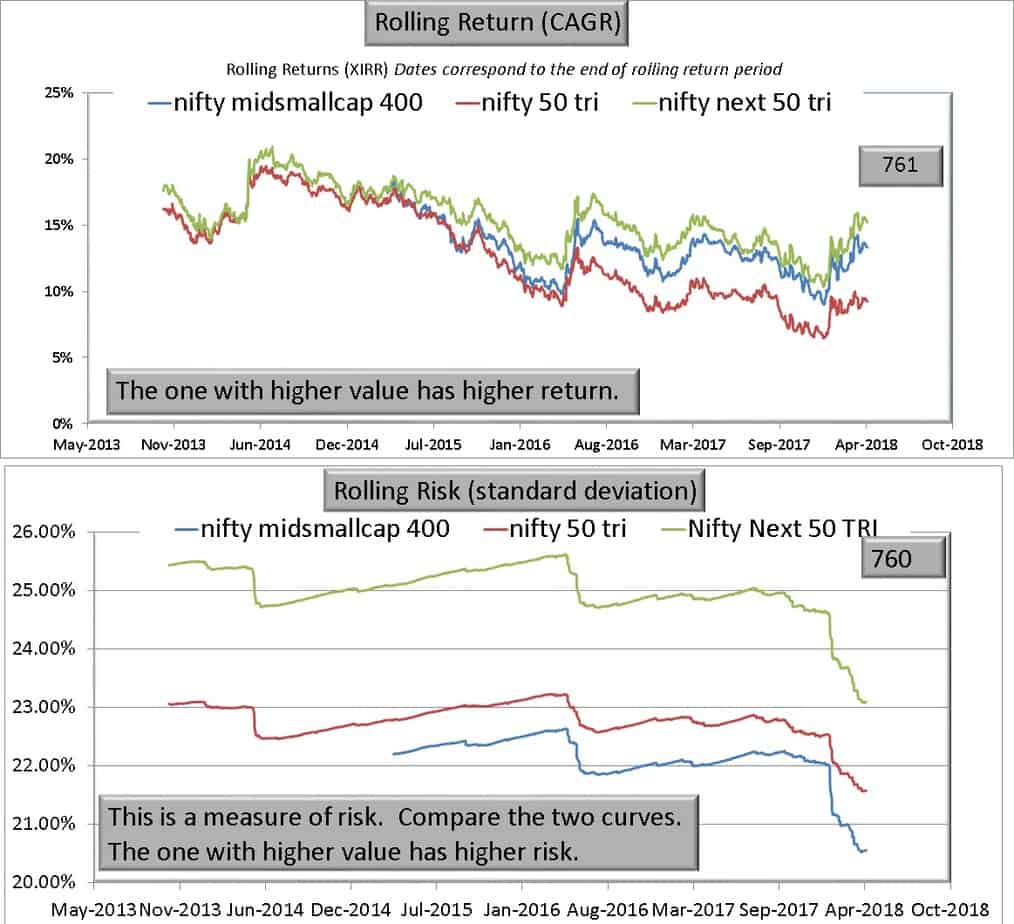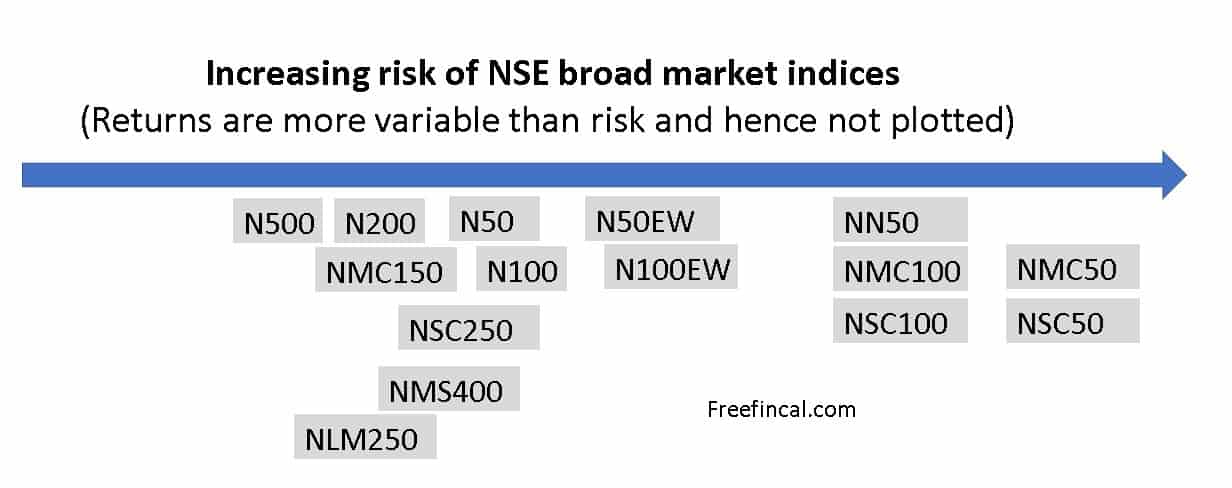Last Updated on August 22, 2022 at 11:17 pm
Regular readers may be aware that I have repeatedly pointed out how hard it is for mutual funds to beat the NIfty Next 50 (NN50) index in terms of absolute return* and that no active mutual fund uses it as a benchmark! In this post, I classify NSE indices in terms of risk and point out the unique position of the Nifty Next 50. Let us try to answer two questions: (1) Which index has a risk-return profile similar to the NN50? (2) Is there any index that has offered better returns at lower risk than the NN50? This post is inspired by Subrat Dash who asked this question in FB group Asan Ideas for Wealth.
* And how easy it is to lower risk compared to the NN50. As usual many seem to have ignored this fact because they allegedly have “a high-risk appetite”. Well, hope they have some antacid stocked up. Note: SEBI in its mutual fund classification circular has stated the following as a definition for large-cap stocks: 1st -100th company in terms of full market capitalization. If you take this seriously then, the NN50 will be called a large cap, as you will see below, it is not!
Nifty Next 50 resources
What is the NIfty Next 50?
The NIFTY Next 50 Index represents 50 companies from NIFTY 100 after excluding the NIFTY 50 companies.
- The NIFTY Next 50 Index represents about 11.9% of the free float market capitalization of the stocks listed on NSE as on March 31, 2017.
- The total traded value for the last six months March 2017 of all index constituents is approximately 15.4% of the traded value of all stocks on NSE. Source: NSE
These are the previous posts on NN50:
Join 32,000+ readers and get free money management solutions delivered to your inbox! Subscribe to get posts via email! (Link takes you to our email sign-up form)
🔥Want to create a complete financial plan? Learn goal-based investing? Exclusive access to our DIY tools? Increase your income with your skills? Enjoy massive discounts on our robo-advisory tool & courses! 🔥
This is my portfolio vs Sensex, Nifty Next 50: Want to Check yours?
Nifty Next 50: The Benchmark Index That No Mutual Fund Would Touch?!
Evaluating the Nifty Next 50 as an Index Fund
How to classify an instrument, asset class or index?
We classify based on volatility and not based on returns. Suppose you ask “which instrument will offer me 25% return?”. The answer is: Sometimes gold can offer 25%, sometimes stocks can, sometimes real estate can, sometimes even govt bonds can, sometimes currencies can … The answer is accurate, but not useful because the question is inaccurate. A better question would be, “how often would I get 25% from X.Y or Z instrument and at what risk?”
The point is, it is rik the differentiates instruments as pointed out here: Investing in Cryptocoin vs Trading in Cryptocoin (this post is not just about crypto) and here: The key to successful mutual fund investing and here: When to choose what mutual fund? and here: Gold is riskier than Stocks!
The NSE broad market index classification
Starting from the top 500 companies based on full market capitalisation, NSE has derived the following indices. Source: broad market methodology. We will be studying these indices below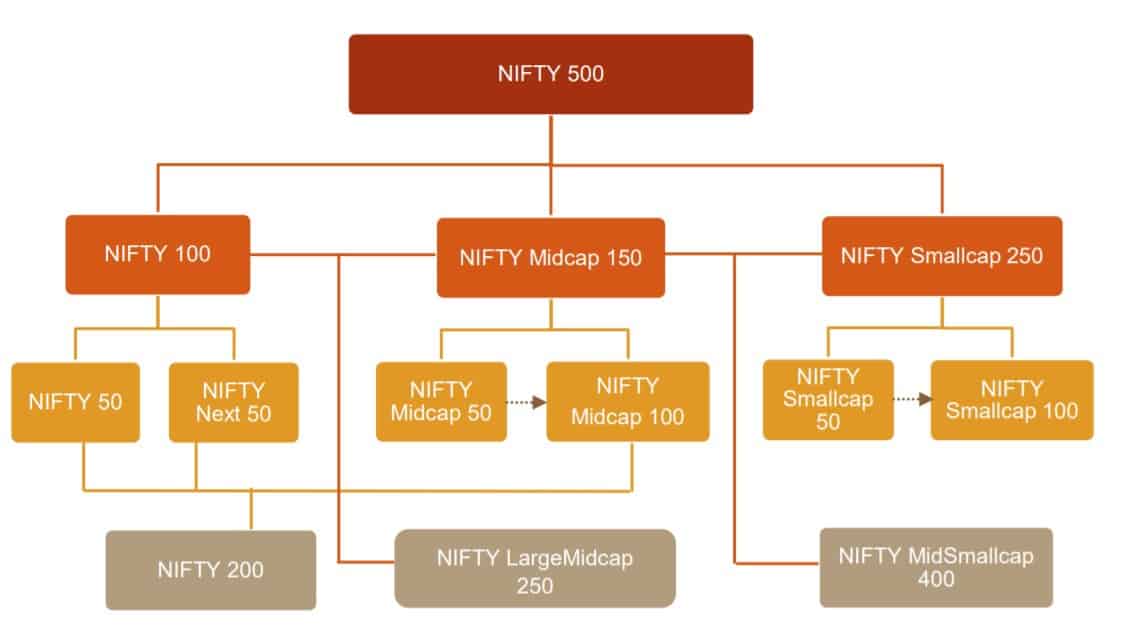 We will consider both rolling returns (higher is better duh!) and rolling standard deviation (a measure of volatility – lowe is better) over a ten year period and use the Nifty 50 (N50) and the Nifty Next 50 as dual benchmarks. As mentioned above, our goal is to answer two questions: 1) Which index has a risk-return profile similar to the NN50? (2) Is there any index that has offered better returns at lower risk than the NN50?
We will consider both rolling returns (higher is better duh!) and rolling standard deviation (a measure of volatility – lowe is better) over a ten year period and use the Nifty 50 (N50) and the Nifty Next 50 as dual benchmarks. As mentioned above, our goal is to answer two questions: 1) Which index has a risk-return profile similar to the NN50? (2) Is there any index that has offered better returns at lower risk than the NN50?
NIfty 50 vs Nifty Next 50
The top panel has 10Y rolling returns with 1119 (10-year return) data points. The bottom panel has 10Y rolling risk with 1119 data points. This will be the pattern followed for all the graphs that you will see below.
Notice that the NN50 has generally done better than the N50 in the 5-year window considered (see horizontal axis) but it about 10% more volatile (this is significant). We will now consider other broad market indices with these two as reference points.
Nifty Equal weight 50 (N50EW) vs N50 vs NN50
The equal weight index will have an equal allocation to all 50 stocks. See: Nifty 50 Equal Weight Index vs Nifty 50: Does equal weight result in more returns?
Notice that N50EW has a bit more risk than N50 due to the stock weight difference but returns may not always be higher.
Nifty 100 vs N50 vs NN50
If I add N50 and NN50 will I get the partial benefits of NN50?
The answer is no! Because stocks with higher market caps will have a higher weight. N100 has a similar risk profile as N50 and offers a bit more returns, but not too much and not always.
Nifty 100 equal weight (N100EW) vs N50 vs NN50
So what if I choose equal weights of the top 100 stocks?
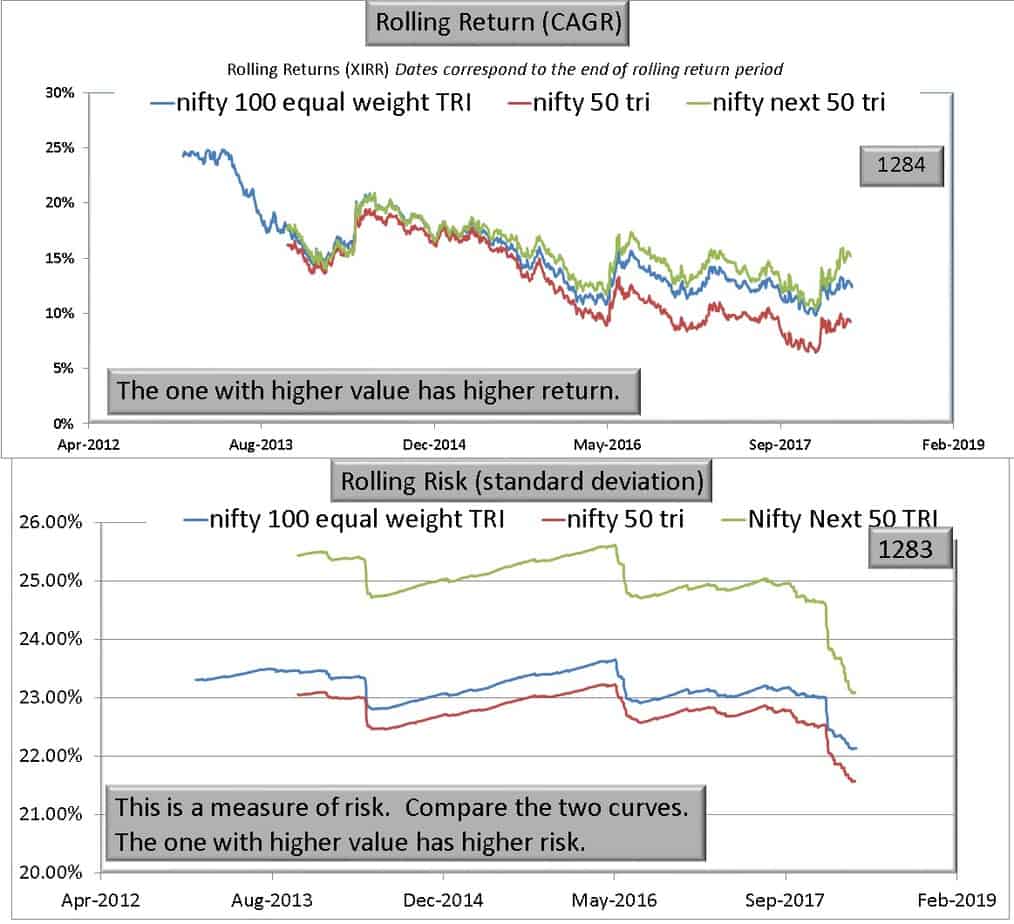 That is not bad at all! N100EW offers a reward close to N50 but with significantly lower risk. This is a good alternative for those who cannot handle the excessive volatility of NN50.
That is not bad at all! N100EW offers a reward close to N50 but with significantly lower risk. This is a good alternative for those who cannot handle the excessive volatility of NN50.
N200 vs N50 vs NN50
What happens if we add 100 more stocks to make it N200?
Notice how diversification reduced risk but not retains returns. N200 is a better than choice than N50 if we go by this.
N500 vs N50 vs NN50
Now make it 500 stocks!
Again lower risk than N50 and N100 and returns close to N50.
Nifty Midcap 150 (NMC150) vs N50 vs NN50
NIFTY Midcap 150 represents the next 150 companies (companies ranked 101-250) based on full market capitalisation from NIFTY 500.
This again is a pretty good choice! Lower risk than N50 (diversification due to more stocks)
NIfty Smallcap 250 (NSC250) vs N50 vs NN50
NIFTY Smallcap 250 represents the balance 250 companies (companies ranked 251- 500) from NIFTY 500
Nifty Midcap 50 (NMC50) vs N50 vs NN50
It includes top 50 companies based on full market capitalisation from NIFTY Midcap 150 index and on which derivative contracts are available on NSE. In case 50 midcap stocks do not have derivatives contract available on them then it could have less than 50 stocks in the index
Nifty Midcap 100 (NMC100) vs N50 vs NN50
It includes all companies from NIFTY Midcap 50. Remaining companies are selected based on average daily turnover from NIFTY Midcap 150 index
Nifty Smallcap 50 (NMC50) vs N50 vs NN50
It represents top 50 companies selected based on average daily turnover from top 100 companies selected based on full market capitalisation in NIFTY Smallcap 250 index.
Nifty Smallcap 100 (NMC100) vs N50 vs NN50
It includes all companies from NIFTY Smallcap 50. Remaining companies are selected based on average daily turnover from top 150 companies selected based on full market capitalisation from NIFTY Smallcap 250 index
Amusing that this has a risk as much an NN50 but poor 10Y returns!!
NIFTY LargeMidcap 250 (NLM250) vs N50 vs NN50
It includes all companies from NIFTY 100 and NIFTY Midcap 150
NIFTY MidSmallcap 400 (NMS400) vs N50 vs NN50
It includes all companies from NIFTY Midcap 150 and NIFTY Smallcap 250
Summary of increasing risk
If you have got to this point (most people who opened this post will not have, other than to skip to the conclusion), then, thank you!
1: NIfty 100 Equal Weight and Nifty MIdcap 150 are impressive when compared to Nifty Next 50
2: Nifty Next 50 has a risk comparable to mid-cap and small-cap indices. So beware!
stay tuned for part 2! In this post, we identified two indices that have a return a bit less than NN50 but with much lower risk. Is there an index with a higher return than NN50 and lowe risk than N50? To be continued.
🔥Enjoy massive discounts on our courses, robo-advisory tool and exclusive investor circle! 🔥& join our community of 7000+ users!
Use our Robo-advisory Tool for a start-to-finish financial plan! ⇐ More than 2,500 investors and advisors use this!
Track your mutual funds and stock investments with this Google Sheet!
We also publish monthly equity mutual funds, debt and hybrid mutual funds, index funds and ETF screeners and momentum, low-volatility stock screeners.





- Do you have a comment about the above article? Reach out to us on Twitter: @freefincal or @pattufreefincal
- Have a question? Subscribe to our newsletter using the form below.
- Hit 'reply' to any email from us! We do not offer personalized investment advice. We can write a detailed article without mentioning your name if you have a generic question.
Join 32,000+ readers and get free money management solutions delivered to your inbox! Subscribe to get posts via email! (Link takes you to our email sign-up form)
About The Author
 Dr M. Pattabiraman(PhD) is the founder, managing editor and primary author of freefincal. He is an associate professor at the Indian Institute of Technology, Madras. He has over ten years of experience publishing news analysis, research and financial product development. Connect with him via Twitter(X), Linkedin, or YouTube. Pattabiraman has co-authored three print books: (1) You can be rich too with goal-based investing (CNBC TV18) for DIY investors. (2) Gamechanger for young earners. (3) Chinchu Gets a Superpower! for kids. He has also written seven other free e-books on various money management topics. He is a patron and co-founder of “Fee-only India,” an organisation promoting unbiased, commission-free investment advice.
Dr M. Pattabiraman(PhD) is the founder, managing editor and primary author of freefincal. He is an associate professor at the Indian Institute of Technology, Madras. He has over ten years of experience publishing news analysis, research and financial product development. Connect with him via Twitter(X), Linkedin, or YouTube. Pattabiraman has co-authored three print books: (1) You can be rich too with goal-based investing (CNBC TV18) for DIY investors. (2) Gamechanger for young earners. (3) Chinchu Gets a Superpower! for kids. He has also written seven other free e-books on various money management topics. He is a patron and co-founder of “Fee-only India,” an organisation promoting unbiased, commission-free investment advice.Our flagship course! Learn to manage your portfolio like a pro to achieve your goals regardless of market conditions! ⇐ More than 3,000 investors and advisors are part of our exclusive community! Get clarity on how to plan for your goals and achieve the necessary corpus no matter the market condition is!! Watch the first lecture for free! One-time payment! No recurring fees! Life-long access to videos! Reduce fear, uncertainty and doubt while investing! Learn how to plan for your goals before and after retirement with confidence.
Our new course! Increase your income by getting people to pay for your skills! ⇐ More than 700 salaried employees, entrepreneurs and financial advisors are part of our exclusive community! Learn how to get people to pay for your skills! Whether you are a professional or small business owner who wants more clients via online visibility or a salaried person wanting a side income or passive income, we will show you how to achieve this by showcasing your skills and building a community that trusts and pays you! (watch 1st lecture for free). One-time payment! No recurring fees! Life-long access to videos!
Our new book for kids: “Chinchu Gets a Superpower!” is now available!


Must-read book even for adults! This is something that every parent should teach their kids right from their young age. The importance of money management and decision making based on their wants and needs. Very nicely written in simple terms. - Arun.Buy the book: Chinchu gets a superpower for your child!
How to profit from content writing: Our new ebook is for those interested in getting side income via content writing. It is available at a 50% discount for Rs. 500 only!
Do you want to check if the market is overvalued or undervalued? Use our market valuation tool (it will work with any index!), or get the Tactical Buy/Sell timing tool!
We publish monthly mutual fund screeners and momentum, low-volatility stock screeners.
About freefincal & its content policy. Freefincal is a News Media Organization dedicated to providing original analysis, reports, reviews and insights on mutual funds, stocks, investing, retirement and personal finance developments. We do so without conflict of interest and bias. Follow us on Google News. Freefincal serves more than three million readers a year (5 million page views) with articles based only on factual information and detailed analysis by its authors. All statements made will be verified with credible and knowledgeable sources before publication. Freefincal does not publish paid articles, promotions, PR, satire or opinions without data. All opinions will be inferences backed by verifiable, reproducible evidence/data. Contact information: To get in touch, use this contact form. (Sponsored posts or paid collaborations will not be entertained.)
Connect with us on social media
- Twitter @freefincal
- Subscribe to our YouTube Videos
- Posts feed via Feedburner.
Our publications
You Can Be Rich Too with Goal-Based Investing
 Published by CNBC TV18, this book is meant to help you ask the right questions and seek the correct answers, and since it comes with nine online calculators, you can also create custom solutions for your lifestyle! Get it now.
Published by CNBC TV18, this book is meant to help you ask the right questions and seek the correct answers, and since it comes with nine online calculators, you can also create custom solutions for your lifestyle! Get it now.Gamechanger: Forget Startups, Join Corporate & Still Live the Rich Life You Want
 This book is meant for young earners to get their basics right from day one! It will also help you travel to exotic places at a low cost! Get it or gift it to a young earner.
This book is meant for young earners to get their basics right from day one! It will also help you travel to exotic places at a low cost! Get it or gift it to a young earner.Your Ultimate Guide to Travel
 This is an in-depth dive into vacation planning, finding cheap flights, budget accommodation, what to do when travelling, and how travelling slowly is better financially and psychologically, with links to the web pages and hand-holding at every step. Get the pdf for Rs 300 (instant download)
This is an in-depth dive into vacation planning, finding cheap flights, budget accommodation, what to do when travelling, and how travelling slowly is better financially and psychologically, with links to the web pages and hand-holding at every step. Get the pdf for Rs 300 (instant download)